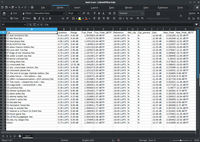
Photo from wikipedia
Background In patients with rheumatoid arthritis (RA) different joints were shown to share the same dominant T-cell clones, suggesting shared characteristics of the inflammatory process and indicating that strategies to… Click to show full abstract
Background In patients with rheumatoid arthritis (RA) different joints were shown to share the same dominant T-cell clones, suggesting shared characteristics of the inflammatory process and indicating that strategies to selectively target the antigen receptor might be feasible. Since T- and B-lymphocytes closely interact in adaptive responses, we analysed to what extent different joints also share dominant B-cell clones. Methods In 11 RA patients, quantitative B-cell receptor (BCR) repertoire analysis was performed in simultaneously obtained samples from inflamed synovial tissue (ST) from distinct locations within one joint, from multiple joints, from synovial fluid (SF) and peripheral blood (PB). Results ST biopsies from different locations in the same joint showed clear overlap in the top-25 dominant BCR clones (16.7%, SD 12.5), in the same range as the overlap between ST and SF in the same joint (8.0%, SD 8.8) and the overlap between ST-ST between different joints (9.1%, SD 8.2), but clearly higher than the overlap between ST and PB (1.7%, SD 2.4; p<0.05) and SF and PB (2.7%, SD 4.1; p<0.05). Interestingly, these figures were substantially lower than the overlap observed in previous T-cell clonality studies. Conclusions We conclude that in RA BCR clonal responses may be more localized than TCR clonal responses, pointing to antigen-selective influx, proliferation and/or maturation of B-cells. B lineage cells in the SF may adequately represent the dominant BCR clones of the ST, which is in contrast to T-cells. Collectively, the presence of shared B- and especially T-cells in different joints from the same patient suggests that approaches might be feasible that aim to develop antigen-receptor specific targeting of lymphocyte clones in RA as an alternative to more generalized immunosuppressive strategies.
Journal Title: Frontiers in Immunology
Year Published: 2022
Link to full text (if available)
Share on Social Media: Sign Up to like & get
recommendations!